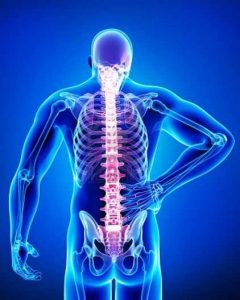

Although most lower back pain and sciatica is very treatable and is not permanent it’s advisable to consult your GP to obtain an objective diagnosis of the condition, a course of treatment , and a strategy to prevent a reoccurrence such as the formulation of a daily exercise routine. If the sciatica can be managed then this should alleviate the need for more radical future treatment such as surgery, should the condition is allowed to become chronic or long term.
What is Sciatica?
Sciatica strictly speaking isn’t one condition, but is a often a generic term applied to a number of symptoms, that could be brought about as a result of irritation of the sacral nerve roots from the spine that converge to form the sciatic nerves. Usually, the symptoms will only be experienced on one side.
Sciatica is usually triggered by the compression of nerves in the lumbar region or sacrum at the base of the back or indeed the sciatic nerve itself.
This nerve compression or irritation results in pain in that area or sensations or numbness down into the thigh or legs. Effectively we are causing a “short circuit” of the neurological transmissions from below the point of the nerve irritation.
Causes of Sciatica
Causes of Sciatica can include:
Spinal prolapsed disc or lumbar disc herniation
Most Sciatica is brought about as a result of a spinal disc bulge where distortion or pressure exerted on the vertebrae has caused the intervertebral disc to be pushed (prolapsed) onto the nerves, or a herniated disc in the lower spine, where the soft inner pulp has been pushed through a tear in the outer wall, protruding onto the nerve. Pressure on the nerve causing leg or back pain can also be caused by or vertebral misalignment or degenerated discs.
Spinal Stenosis
This occurs where the channel through which the spinal cord runs (spinal canal) becomes narrow, maybe as a result of a herniated disc, a bone spur or misalignment of a spinal segment (Spondylolisthesis), inflammation. This reduction in space may cause compression and irritation of the nerves and subsequent back pain in the sciatic nerve roots
Piriformis Syndrome
This can occur where the piriformis muscle compresses the sciatic nerve, as a result of the muscle suffering trauma such as a strain or spasm and tensing around the nerve. This can occur in the minority of the population where the sciatic nerve actually runs through the piriformis muscle, rather than underneath it.
Posture or work related Sciatica
Posture related sciatica or work related sciatica can be brought on by such factors as long periods of standing e.g. hairdressers, or occupational activities which cause distortion or misalignment over time of the sacral joint e.g. one sided carrying or operation of equipment such as tool belts or shoulder held hedging strimmers.
Pregnancy
Compression of the sciatic nerve and therefore back pain or sciatic pain can occur as a result of pressure from the uterus or again through spine alignment changes and alignment, arising from physical changes from carrying the foetus and changes in the spinal loading.
Trigger Points
Although the subsequent pain is similar to that associated with sciatic nerve compression or irritation, this occurs in the trigger points of the lower back muscles and gluteus muscles (buttocks) have poor blood flow as a result of trauma or muscular contraction or spasm.
Symptoms of Sciatica
Symptoms of sciatica may include:-
Numbness or tingling in the lower back, buttocks, or legs
Sharp or stabbing pain from below that point in the legs or buttocks
Stinging or burning sensations, or cramping felt in the thigh
These pains may increase where there is sudden or exaggerated movement in lumbar region e.g. stretching, twisting, or sneezing which may have the effect of further irritating the affected nerves. Your GP will carry out a physical examination, usually determining the amount of movement and their pain thresholds in the lumbar region and legs, and sometimes following up if need be with x-ray, CT or MRI scans if necessary to establish root cause.
Treatment for Sciatica
Treatment for sciatica usually involves addressing the sciatica pain and inflammation initially, relaxing the muscles.
Over the counter pain killers are often effective along with anti inflammatory medication or ice packs in dealing with the initial discomfort. If the pain is more severe, then your GP may prescribe a more powerful epidural steroid injection to reduce the pain by easing the inflammation to the sciatic nerve.
Rest is not regarded as the best therapy for back pain or sciatica. Indeed, there are exercises that can be carried out if there is a bout of sciatica. Stretching exercises or Yogic positions may be carried to decrease pressure on the sciatic nerve by relaxing muscle tension in the affected area.
Once the sciatic pain and inflammation is under under control then a course of back pain therapy and / or stretching exercise routines can be devised by your GP to strengthen and tone the lower back in order to reduce the risk of recurrence of the sciatica. Indeed having an effective exercise routine for sciatica can be the most successful strategy in controlling or managing the condition
